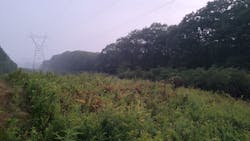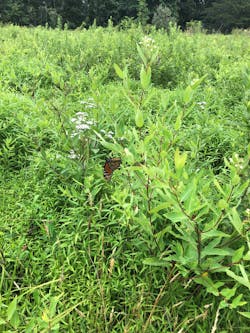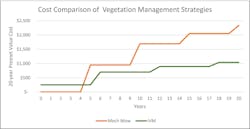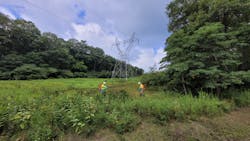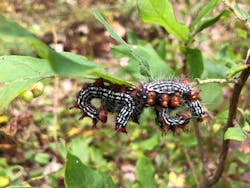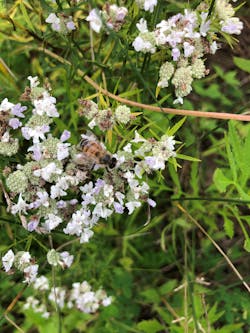Beyond the Butterfly: Managing Rights-of-Way In Vegetation Management
The world of transmission utility vegetation management (UVM) since the 2003 blackout has been largely focused on the removal of incompatible vegetation on rights of way (ROWs). While that is a legitimate strategy for preventing transmission outages and ensuring compliance, it fails to acknowledge the omnipresent allies that already exist on, adjacent to, or nearby ROWs: those native ecosystems that naturally resist tall-growing plants.
Establishing a robust ecosystem on the ROW is about more than protecting against the listing of a single endangered species; it creates ecological momentum for compatible ecosystems, reducing physical, chemical and financial inputs while improving the health of the ecosystems that utilities control.
The Business Case for IVM
On-the-ground UVM is typically focused on suppressing incompatible species to satisfy stakeholders and achieve compliance. Many utility vegetation managers believe that all they must do to be successful is suppress incompatible species. While perhaps sufficient for compliance and safety, this falls far short of the mark for a comprehensive Integrated Vegetation Management (IVM) program.
Most utility vegetation managers are at least aware of IVM, and many will claim to practice IVM in their day-to-day management. When discussing the establishment of healthy ecosystems on ROWs, however, it’s important to note that a spray program is not the same thing as an IVM program. Vegetation managers across North America have been highly successful in using herbicides to suppress undesirable vegetation, but these are usually cyclic spray projects and not equivalent to a comprehensive IVM program. Importantly, a cyclic mowing program will typically cost significantly more than an IVM program on the same ROW. This is true even if the program incorporates some chemical controls if they are not part of a comprehensive IVM program.
The process of encouraging compatible vegetation while reducing incompatibles eventually leads to fewer management inputs and greater cost savings over the long term. A recent paper by John Goodfellow on “The Cost-Efficiency of IVM” shows how, after just five years, a comprehensive IVM program will be less costly than a typical mow and hand-cut program.
In addition to the cost-efficiency and cost savings, IVM creates ecological function, resiliency and momentum, which will greatly improve stakeholder relations. A comprehensive IVM program will actively incorporate adaptive management, action thresholds and cyclic adjustments to continuously improve the program and reduce its costs over time. This approach differs from the method of implementing a series of repeated mow and spray projects that generally cost the same each year and treat large swaths of ROW the same, removing compatible and incompatible vegetation in the same broad strokes.
Using Nature as an Ally on the ROW
Biological controls can include small animals that consume tree seeds, deer that browse woody vegetation and compatible plants outcompeting incompatible seedlings. It can also encompass low-growing native plants releasing chemicals into the soil to inhibit the growth of other plants and even native soil fungal and bacterial communities predisposing the soil to favor compatible native plant growth. To achieve these sorts of controls, the ROW needs to be managed to encourage and promote compatible plant growth while selectively removing incompatible species. Specifically, the floor (area directly beneath the power lines) is usually converted into low-growing native plant communities such as those found in early successional habitats.
Early successional plant communities tend to be the first to repopulate a site after a disturbance. For example, early succession often occurs immediately following a large blow-down of trees in a forest, exposing the previously shaded forest floor to sunlight. This added light prompts dormant seeds in the soil to germinate and begin to grow. What results is a community predominantly composed of shrubs, forbs and grasses. In a forested setting, this is how meadows form. Many animal species are adapted to these environments, including deer and mice.
Native plants and animals that naturally occur in early successional environments have developed adaptations to prevent the invasion of trees. In the case of animals, this might be consumption of young trees and tree seeds. In the case of plants, this might include soil changes and shading to inhibit tree growth. It is these natural adaptations that utilities use to their advantage in ROW management. Any adaptation that compatible plants and native animals use to inhibit incompatible plant growth can be considered a biological control. No one pays for these controls; rather, the IVM system of management seeks to establish healthy, robust, stable and resilient low-growing plant communities, which use biological controls to sustain themselves.
Using IVM to establish low-growing native plant communities on the ROW is an ongoing process that typically requires the most work upfront and progressively fewer management inputs as time goes on. The process often starts with the initial establishment of the ROW, or reclamation of an overgrown ROW, where all plants in the management area are removed through mechanical and/or chemical means. Then, selective physical and chemical treatments are used on a regular basis to remove incompatibles while favoring compatibles — especially those that would naturally comprise an early successional native habitat.
After each treatment cycle, managers review how well they are doing by taking stock of what plants are present in the treatment areas and adjusting future treatments accordingly. Treatments become more selective in their chemistry and application over time as fewer incompatibles are present on the ROW. The time it takes to establish a resistant ecosystem varies, though results can be dramatic after just one treatment. No ecosystem will ever become completely resistant to invasion from incompatibles. Still, as native compatible ecosystems are established and managed, less money will be required to remove incompatible plants.
To be clear, establishing a native, low-growing plant community is not appropriate everywhere on the ROW. Constraints such as ownership, stakeholder requirements, cultural uses, environmental regulations and access can affect what “compatible vegetation” means and what the goals are. IVM is about using adaptive management to continuously improve management strategies to favor compatible vegetation, whether that is lawn or milkweed.
Building Ecological Momentum
Shifting focus from removing incompatible vegetation to the establishment and maintenance of compatibles will maintain regulatory compliance and move the program toward ecological function including biological controls. To achieve both the cost and ecological benefits, ROWs need to be surveyed for present plant communities, and strategies must be developed to convert those communities into desirable ecosystems. Current utility vegetation managers do not need experience with this type of program to get started in IVM. Instead, they can use industry guidelines and best practices to begin incorporating adaptive management into their program, and when necessary, contract local ecologists for guidance. The key is creating good specifications and requiring skilled labor.
Managing ecologically means working with nature to create an ecosystem that is largely self-sustaining. This is a sort of “ecological momentum,” as healthy and well-established ecosystems tend to have robust mechanisms for maintaining dominance over the lands they occupy. If no significant disturbances occur, it takes many years for an established ecosystem to convert into something different.
Cost savings usually occur relatively soon after converting to compatibles-based management, but they continue to grow because this ecological momentum increases steadily over time. Increasingly, only minimal treatments are required to remove sparse occurrences of trees, invasive plants and other incompatibles that arise.
Modern research suggests that soil health may have a lot to do with this ecological momentum, and that above-ground plant communities directly impact the composition of below-ground microflora and microfauna. In other words, as ROWs are converted from a hodgepodge of native and invasive plants into established, native, compatible ecosystems, utilities are likely also reaping the secondary benefit of remediating the soil health on these lands. This benefits local native plants and animals and may make it harder for invasive and incompatible plants to establish over time. This is also a good reason to follow the best management practice of excluding invasive vegetation from the ROW, even if its mature height is compatible with the wire zone. Invasive plants are detrimental to local ecosystems and may interfere with native plant communities’ biological controls. Allowing invasive plants on the ROW is not compatible with environmental stewardship.
A growing body of knowledge shows that plant communities dominated by native vegetation provide the greatest foundation for functional food webs. Researchers like Dr. Doug Tallamy, University of Delaware, are gaining attention as they link native plant abundance to the abundance of charismatic animals such as birds. Plants absorb energy from the sun and convert it to food. Native plants are generally the most suitable hosts and food for many native animals such as pollinators, mammals and caterpillars. An abundance of these primary plant consumers will, in turn, benefit animals in higher trophic levels such as birds. Without healthy native plant communities to feed primary consumers and support local pollinators, the natural systems that drive local and regional ecosystems can collapse, which can have serious repercussions for natural and human wellbeing.
A 2006 paper by Klein et. al. on the “Importance of pollinators in changing landscapes for world crops” estimates that roughly 35% of the world’s crop production requires animal pollinators. Even aside from the business case for IVM, the health of the planet’s ecosystems is an important reason to practice sound ecological land management. Utilities can help steer the ship of ecological momentum in the communities they serve, using the millions of acres they manage as reservoirs for functional native ecosystems in a world where land is increasingly fragmented and converted away from natural land cover.
Start Somewhere
The Utility Arborist Association (UAA) Environmental Stewardship Committee’s 2021 guide to “Managing Compatible Vegetation for Targeted Species and Biodiversity,” available for free on the UAA website, can help utility vegetation managers interested in taking advantage of biological controls. The guide lists three primary approaches to managing compatible vegetation for healthy ecology: protection, enhancement and integrity.
Protection-based approaches focus on preserving compatible vegetation that already exists on the ROW, both through avoiding direct impacts and ensuring that damaging agents such as invasive plants do not harm existing compatibles. Enhancement-based approaches focus on increasing the amount of compatible vegetation present, either through direct planting or through creating conditions where current and potential populations of compatibles are likely to grow. An integrity-based approach stewards natural systems in ways that promote communities of compatible vegetation to thrive, proliferate and stabilize. Integrity-based approaches are more complex and tend to come with IVM program maturity; in a way, they are approaches that seek to generate and increase the “ecological momentum” discussed earlier.
The Environmental Stewardship section of the UAA website has resources for utility vegetation managers looking to get started on an IVM program. These include a slide deck for a business case presentation, a net present value cost calculator and a multitude of examples, videos, guides and case studies of successful program management. Making the business case is generally the first step in creating buy-in by senior leadership and those who make the final call on whether a UVM program can transition to IVM.
As with most institutional change, there will be a short period of increased cost as the IVM program is initiated on top of the existing VM program. It is important for vegetation managers to be upfront with stakeholders about these expenses while also stressing that costs will decrease significantly as the program matures. Utilities already including mechanical clearing (e.g., mowing) followed by broadcast chemical controls (e.g., cut stubble) in their maintenance cycle have a head start on IVM, as most of the upfront cost is associated with this type of combined treatment.
Sound ecological ROW management through IVM will provide many other benefits such as improvements to utility ESG KPIs, improved stakeholder relations, reduced risk of adverse environmental impacts, reduced risk of mid-cycle vegetation encroachment on conductors and numerous benefits to local plants and wildlife. Additionally, utilities can assume that sound ecological practices will benefit them if environmental regulations change or strengthen in the future, or if a protected species is discovered on a management site.
Establishing a comprehensive IVM program is a sound investment in the future of the lands a utility manages. As healthy ecosystems are established, the frequency and amount of vegetation management inputs will decrease, reducing program costs. The financial sustainability of the ROW management program will align directly with environmental sustainability and stewardship on the utility’s lands. As native plant cover leads to ecosystem health, native pollinators and other animals will use the ROW as habitat, further increasing positive environmental impact. Public and stakeholder relations will improve as lands are managed ethically and with the future of the environment in focus. As management costs go down, ratepayers’ costs can also be reduced. When the utility is engaged in a comprehensive IVM program, their customers can thank native plants and animals on the ROW for helping to lower their electric bill.
Kieran Hunt ([email protected]) is municipal manager with Asplundh Technical Services and works with Asplundh’s field operations to improve and expand municipal and roadside vegetation management programs. His background is in municipal and utility vegetation management, inventory and work planning.
He is an ISA Certified Arborist Utility Specialist and a New Jersey Licensed Tree Expert and has a bachelor’s degree in ecology from Rutgers University.
About the Author
Kieran Hunt
Kieran Hunt ([email protected]) is municipal manager with Asplundh Technical Services and works with Asplundh’s field operations to improve and expand municipal and roadside vegetation management programs. His background is in municipal and utility vegetation management, inventory, and work planning. He is an ISA certified arborist utility specialist and a New Jersey Licensed Tree Expert and has a B.S. in ecology from Rutgers University.
